Posted by Kristen Goodhue on January 29th, 2013
by Kristen Minogue

Goose barnacles and brown Sargassum seaweed beached on the Bermuda coast. (Kim Holzer)
The most bizarre scientific legends sometimes come from completely ordinary creatures. Take, for example, the medieval legend of a tree that gave birth to birds.
A few days ago, marine ecologist Kim Holzer discovered a strange can washed up on a Bermuda beach. Washed-up debris can be dangerous, especially when it comes coated with potential invaders. But this can carried nothing extraordinary—except goose barnacles, the crustaceans that spawned one of the oddest scientific myths in Western history.
Click to continue »
Posted in Ecology, Invasive Species | 2 Responses »
Posted by Kristen Goodhue on January 28th, 2013
by Kristina Hill
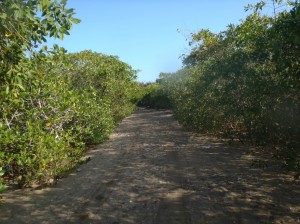
The mangrove-lined path down to Bique beach.
(Kristina Hill)
The first thing on our to-do list for our Panama Part II adventure was to head to Playa Bique on the Pacific Coast of Panama to find more
Striostrea sp. and
Saccostrea palmula oysters. In order to get to Bique, we had to travel down an unpaved, rocky clay road that wended through lush green vegetation with white cows grazing on hillsides. The beautiful scenery distracted me enough that I didn’t feel my head hit the roof of the truck with every single bump in the road, and distracted Katrina enough that she was able to keep her breakfast!
We arrived at Bique to find a small village with brightly colored houses and friendly people. There were also several dogs in the village anxious to welcome us–as we unpacked our gear, one decided to mark his territory right on the side of our bucket! (Is there an old saying about a dog urinating on a bucket bringing scientists good luck? If not, there should be.) Then we tromped down a sandy, mangrove-lined path to the rocky intertidal, where we were able to find the oysters we were looking for.
The Striostrea species we found were large and seemed to like the tidal pools found in the rock formations at low tide. They were large oysters (we were finding 80-100 mm ones), and it looked like people were “harvesting” the meat and leaving the shells behind—it was very difficult to pry the oysters from the rocks without shucking them open. The Saccostrea palmula oysters we found were much smaller (20-60 mm), so they probably aren’t consumed from this location.
We headed back to the lab, cleaned our bucket and set straight to processing the oysters for metazoan and protistan parasite analyses.
Here’s to hoping the rest of our collections go as well!
More stories from Panama >>
Posted in Ecology, Fisheries, Invasive Species, Parasite Hunting, Water Quality | Comments Off on From the Field: A Warm Welcome in Bique
Posted by Kristen Goodhue on January 28th, 2013
by Katrina Lohan
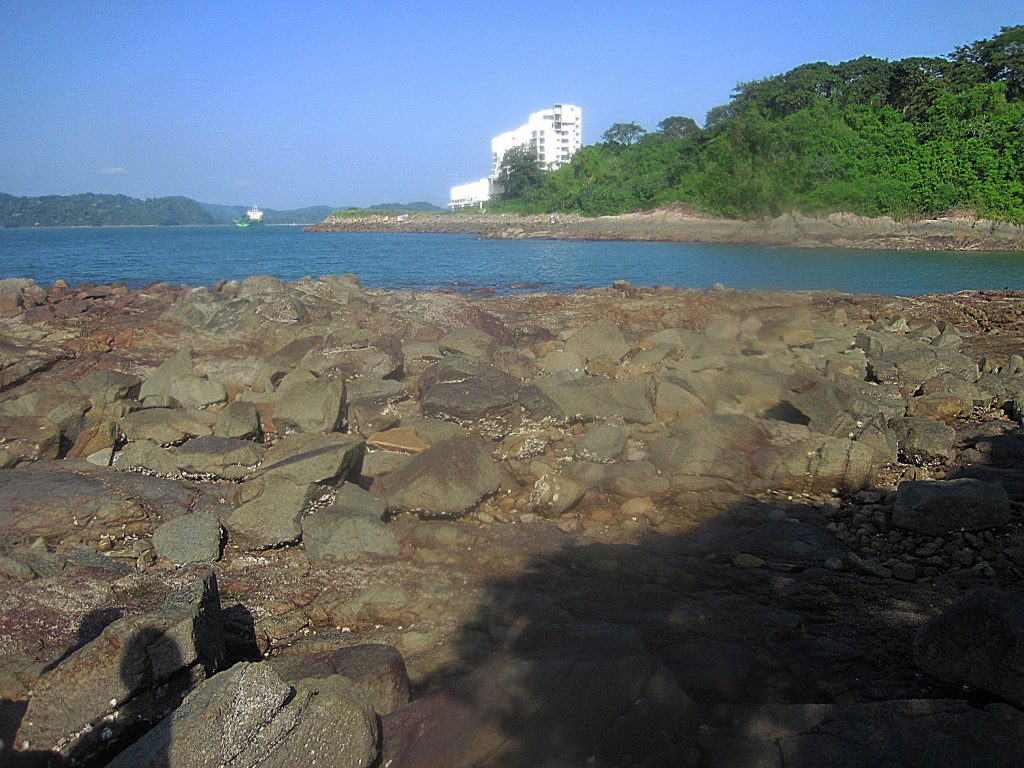
Beach at Punta Culebra, on the Pacific side of the Panama Canal. (Katrina Lohan)
Our first trip to Panama felt like a whirlwind! We learned a lot about what worked and what didn’t for processing all the oysters we collected. We also learned that identifying oysters just by looking at them is really hard. To prepare for this trip, Kristy, Greg and I went to the Smithsonian’s
Natural History Museum to meet with our collaborator,
Ellen Strong, who is the curator of all of the bivalves. She showed us the oyster collection, and the three of us spent a few hours examining the shells of the different oysters. I’m really glad we did, because we all left feeling much more confident in our ability to identify oysters in the field and in the lab–something that will be very useful!
Our current trip to Panama is expected to be three and a half weeks long, and we have an ambitious schedule. The first few days will be spent finishing our collections on the Pacific side of the Panama Canal, then onto the Smithsonian’s Marine Station at Bocas del Toro for a week and half, and then back to the Naos Laboratory to finish sampling the Atlantic side of the Panama Canal. It’s time to put those oyster identifying skills to the test!
More stories from Panama >>
Posted in Ecology, Fisheries, Invasive Species, Parasite Hunting, Water Quality | Comments Off on From the Field: Regresamos a Panamá!
Posted by Kristen Goodhue on December 28th, 2012
by Kristy Hill

The oyster Isognomon sp. in the crevices of a rocky reef at Fort Sherman on the Atlantic coast of Panama. (Kristy Hill)
Yesterday we ventured to the Caribbean coast of Panama, where we had beautiful weather for sampling. Our first stop was near Fort Sherman, a former United States Army base, where we found lots of
Isognomon oysters on the subtidal rocks. These oysters are unusual because instead of cementing their shell to a hard surface, they attach themselves to rocks and mangroves with a threadlike structure. We also were able to collect a
Crassostrea sp. and a few
Ostrea sp. as well.
We then headed to the Smithsonian Tropical Research Institute (STRI) Marine Laboratory in Galeta. We braved the somewhat turbulent waters and snorkeled to collect from the mangroves, despite reports of crocodiles that frequent the area. Oh, the lengths we’ll go to in the name of science.
Click to continue »
Posted in Climate Change, Ecology, Fisheries, Invasive Species, Parasite Hunting, Water Quality | 6 Responses »
Posted by Kristen Goodhue on December 27th, 2012
by Katrina Lohan
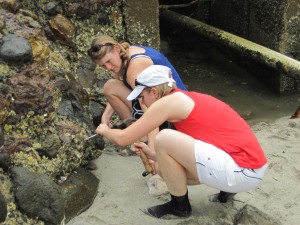
Katrina Lohan and Kristina Hill sample oysters off the rocks near Punta Chame, on the Pacific side of Panama. (Carmen Schloeder)
Some sampling sites are glamorous. Others are not. Our site near Punta Chame was literally off the side of the road. There were lots of rocks just off the road, and then a sandy bank that led to a stream, which led to the ocean. The rocks were covered in oysters, so it was very easy to get all the oyster samples we needed. We found three different species at that site and were able to collect all the oysters and water samples in about an hour.
Interestingly, there were two locations available for water sampling. One spot was an isolated pond influenced by run-off from the road, where the salinity was only 18 ppt. (The average salinity of the ocean is 35 ppt or parts per thousand). The other spot was more of a stream running from the land into the ocean only a few miles away, and the stream’s salinity was 30 ppt. As the salinity of the water can directly impact the parasites, some of which can only survive in high salinity, I opted to take water samples from both bodies of water so I could compare the differences. I’m hoping to get some really interesting results!
Posted in Climate Change, Ecology, Fisheries, Invasive Species, Parasite Hunting, Water Quality | Comments Off on From the Field: Punta Chame–Oysters Galore
Posted by Kristen Goodhue on December 21st, 2012
by Kristen Minogue

A white pickup truck prepares to carry Tuck to a nearby farm. Tuck, a bronze heritage turkey, was discovered wandering alone on SERC property last week. His friendliness around people made staff suspect he was an abandoned pet. (Marvin Dorsey)
The following is a true story about how not to break up with a pet. Tuck (left) is a domestic turkey who found himself alone in the woods, presumably abandoned by his keeper and half-starved when SERC security discovered him last Thursday.
It’s not uncommon to hear about pets left on the sides of streets or in vacant houses when their owners, for one reason or another, decide they’re no longer able to keep them. These stories usually involve dogs, cats or the occasional boa constrictor. In their defense, some owners may believe their pets will be able to fend for themselves in the wild. The owner who dropped off Tuck may have been operating under a similar assumption. Unfortunately the assumption is almost always false.
Click to continue »
Posted in SERC Sites and Scenes | 3 Responses »
Posted by Kristen Goodhue on December 19th, 2012
by Katrina Lohan
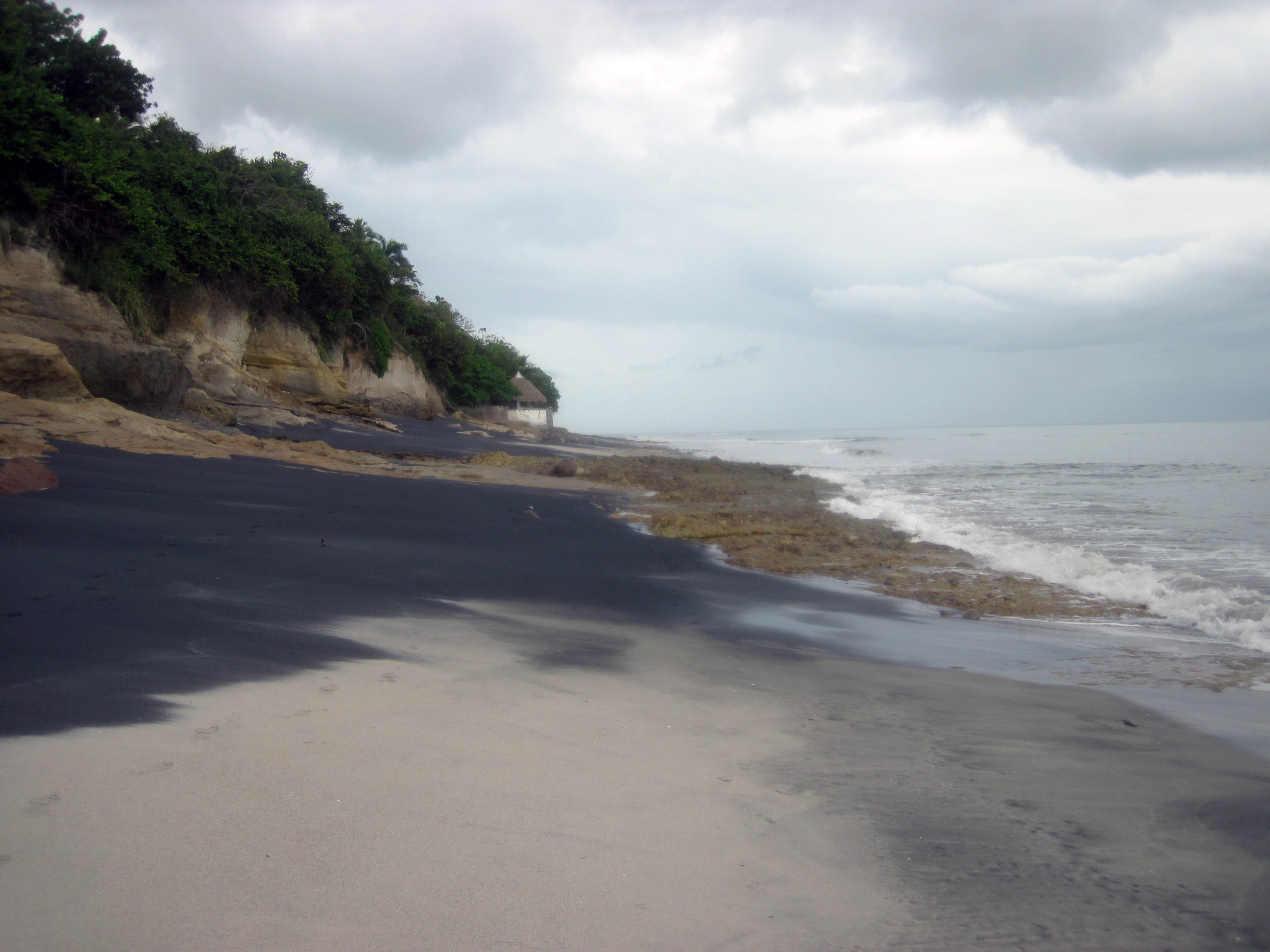
View from Rio Mar on the Pacific side of Panama at high tide (Carmen Schloeder)
On Friday, we ventured to a new location on the Pacific coast to hunt for oysters. Rio Mar is a beach site, so it is unlike our other locations, which thus far have been located in more enclosed estuaries. We headed out to Rio Mar in the hopes of finding some larger oysters in the tidal pools. Fortunately and unfortunately for us, by the time we made it out there, it was high tide. The view of the beach and surrounding area was spectacular, but we weren’t able to sample any oysters. I can’t say I regret going out there, though–what a beautiful beach!
Posted in Climate Change, Ecology, Invasive Species, Parasite Hunting, Water Quality | Comments Off on From the Field: Worth the Drive
Posted by Kristen Goodhue on December 18th, 2012
by Monaca Noble, marine invasions biologist
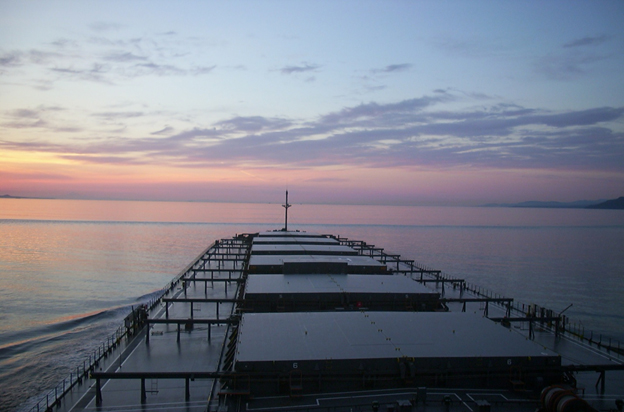
View of the Lily Fortune at sunset from the bridge. (SERC)
Her name was the Lily Fortune. She was a huge red and black cargo ship hauling coal from Canada to a power plant in Japan. Her 10 cargo holds were amazingly clean considering her sooty merchandise. The captain and crew were from the Philippines and were delighted to have two scientists aboard to break up the monotony of their year-long service tours.
Kate Murphy and I flew to Haramachi, Japan, in the spring of 2003. It was only the second time I had used my new passport and I was excited to be going somewhere exotic. It was a new project for both of us, but especially for me. I had never been on a ship or seen a ballast tank. Since we’d be 10 days at sea, Kate wanted to make sure we had everything we could possibly need—pumps, filters, hoses, tools, etc. As a result we had a huge amount luggage. We were picked up from the airport in a cargo van sent by the shipping company. There was no room for us to sit, except for in the back on top of our equipment. I was so excited to see Japan and spent the hour-long ride to the port peering out the tiny window in the back of the van trying to make out as much of the scenery as I could. Unfortunately when we arrived at the port and checked in, we were told we could not go further than the dock. Four days in Japan and we couldn’t leave the ship! It was disappointing. But the disappointment of not seeing Japan was soon replaced with the excitement of being on a commercial ship, getting to know the crew, and setting up our new experiment. There was plenty to keep us busy in the days before the ship sailed.
Click to continue »
Posted in Ecology, Invasive Species | Comments Off on From the Field: Adventures in Ballast Water Sampling on the Pacific
Posted by Kristen Goodhue on December 17th, 2012
by Katrina Lohan
First of all, our stuff arrived! After a few more phone calls to the customs office, everything went smoothly and all of our gear was delivered on Tuesday—not too shabby, really!
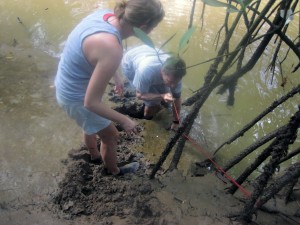
STRI biologist Mark Torchin attempts to climb a stream bank after obtaining oysters from the mangrove roots. (Katrina Lohan)
The next site on our list was called Bique, an intertidal area that has some freshwater input. Many sites on the Pacific side of Panama have large stretches of beach that are uncovered at low tide but completely underwater at high tide. So we are sampling at low tide, when the oysters on the rocks are exposed and much more easily accessible.
At this site, we decided to check out the mangroves first to see if there were any oysters attached to their roots that we could sample. While we found some, they were pretty difficult to get off. Our collaborator, Mark Torchin, thought it safest to strap himself to a mangrove, as the banks were made of soft mud and it is all too easy to fall into the stream. Additional acrobatics, such as scaling mangroves, navigating through root mazes, and climbing back up off the muddy banks, were required to get these oysters, but we prevailed and were able to walk away with about 30 individual oysters.
We then headed back out to scrape oysters off the rocks and found two different species, Saccostrea palmula and a species of Crassostrea, in the rocky intertidal zone. As our supplies had arrived, I now had the equipment necessary to obtain and filter water samples as well, so I walked out along the rocks to get a liter of surface water from the incoming tide. Part of my fellowship research involves comparing the different kinds of parasites in the water column to what is infecting and being filtered by the oysters. Water sampling is just one way of obtaining a more complete picture of parasite diversity in the different sites that we are sampling.
Posted in Climate Change, Ecology, Fisheries, Invasive Species, Parasite Hunting, Water Quality | Comments Off on From the Field: Hanging onto Mangroves
Posted by Kristen Goodhue on December 14th, 2012
by Katrina Lohan
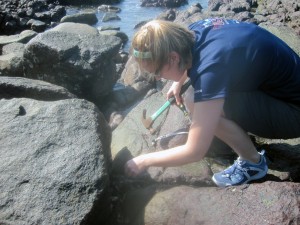
Katrina Lohan, attempting to scrape oysters off a rock at Punta Culebra, Panama. (Kristy Hill)
I would love to be able to say that I am a world traveler with loads of experience visiting other countries, but that would be far from the truth. Unfortunately for me, my passport has only a few stamps. (Two to be precise, as it wasn’t stamped for walking across the border into Mexico or crossing the border to have dinner in Canada.) So traveling to Panama to collect oysters has expanded my horizons in more ways than one!
In Panama, Kristy and I are working with Mark Torchin and Carmen Schloeder, scientists at the Smithsonian Tropical Research Institute in Panama. Our first sampling site was about a five-minute drive from the Smithsonian’s Naos Laboratory, which sits just outside Panama City on the Pacific Ocean.
Click to continue »
Posted in Climate Change, Ecology, Fisheries, Invasive Species, Parasite Hunting, Water Quality | Comments Off on From the Field: Finding Oysters in Panama











